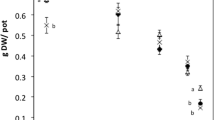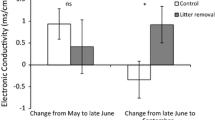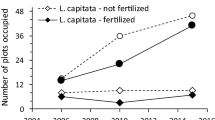Abstract
The rare endemic plant Sidalcea hendersonii (Henderson’s checker-mallow) occurs in tidal marshes of the Pacific Northwest and may be threatened by Lythrum salicaria (purple loosestrife), a European invader plant. We compared the abundances of Lythrum and Sidalcea in a wetland in British Columbia (Canada) in 1999 to those measured in 1979 to track changes in both species. Although the frequency of Sidalcea decreased by more than 50%, and that of Lythrum increased by almost 20%, there was no significant relationship between the changes of the two species. We assessed the potential effects of competition by Lythrum on Sidalcea in field and patio experiments. In the field, we measured the response of Sidalcea to the removal of Lythrum over a two-year period and compared this to the response of Sidalcea to the removal of native species and in unmanipulated control plots. Removal of Lythrum significantly improved the vegetative performance of Sidalcea compared to the removal of randomly selected native plants and the control treatment in the first year. In the second year, the performance of Sidealcea did not differ significantly with treatment. Removals did not influence the reproductive performance of Sidalcea in either year. A one-year additive experiment, carried out in pots, compared the competitive effect of Lythrum on Sidalcea with that of two native species. Lythrum’s impact on Sidalcea was not consistently stronger than that of the native species. Collectively, these results do not indicate a strong impact of Lythrum on the reproduction or abundance of Sidalcea.


Similar content being viewed by others
References
Blossey B, Skinner LC, Taylor J (2001) Impact and management of purple loosestrife (Lythrum salicaria) in North America. Biodivers Conserv 10:1787–1807
Bradfield GE, Porter GL (1982) Vegetation structure and diversity components of a Fraser estuary tidal marsh. Can J Bot 60:440–451
Brown BJ, Mitchell RJ (2001) Competition for pollination: effects of pollen of an invasive plant on seed set of a native congener. Oecologia 129:43–49
Brown BJ, Mitchell RJ, Graham SA (2002) Competition for pollination between an invasive species (purple loosestrife) and a native congener. Ecology 83:2328–2336
Daehler CC (2003) Performance comparisons of co-occurring native and alien invasive plants: implications for conservation and restoration. Annu Rev Ecol Evol Syst 34:183–211
Denoth M (2004) Impact and biological control of Lythrum salicaria in southwestern British Columbia. Dissertation, The University of British Columbia
Denoth M, Myers JH (2005) Variable success of biological control of Lythrum salicaria in British Columbia. Biol Control 32:269–279
Farnsworth EJ, Ellis DR (2001) Is purple loosestrife (Lythrum salicaria) an invasive threat to freshwater wetlands? Conflicting evidence from several ecological metrics. Wetlands 21:199–209
Freckleton RP, Watkinson AR (2000) On detecting and measuring competition in spatially structured plant communities. Ecol Lett 3:423–432
Gaudet CL, Keddy PA (1988) A comparative approach to predicting competitive abilities from plant traits. Nature 334:242–243
Gibson DJ, Connolly J, Hartnett DC et al (1999) Designs for greenhouse studies of interactions between plants. J Ecol 87:1–16
Grabas GP, Laverty TM (1999) The effect of purple loosestrife (Lythrum salicaria L.; Lythraceae) on the pollination and reproductive success of sympatric co-flowering wetland plants. Ecoscience 6:230–242
Gurevitch J, Padilla DK (2004) Are invasive species a major cause of extinctions? Trends Ecol Evol 19:470–474
Hager HA, Vinebrooke RD (2004) Positive relationships between invasive purple loosestrife (Lythrum salicaria) and plant species diversity and abundance in Minnesota wetlands. Can J Bot 82:763–773
Houlahan JE, Findlay CS (2004) Effect of invasive plant species on temperate wetland plant diversity. Conserv Biol 18:1132–1138
Keddy PA (2000) Wetland ecology principles and conservation. Cambridge University Press, Cambridge
Keddy P, Gaudet C, Fraser LH (2000) Effects of low and high nutrients on the competitive hierarchy of 26 shoreline plants. J Ecol 88:413–423
Kery M, Matthies D (2004) Reduced fecundity in small populations of the rare plant Gentianopsis ciliate (Gentianaceae). Plant Biol 6:683–688
Klironomos JN (2002) Feedback with soil biota contributes to plant rarity and invasiveness in communities. Nature 417:67–70
Lavergne S, Debussche M, Thompson JD (2005) Limitations on reproductive success in endemic Aquilegia viscosa (Ranunculaceae) relative to its widespread congener Aquilegia vulgaris: the interplay of herbivory and pollination. Oecologia 142:212–220
Lunneborg CE (2000) Data analysis by resampling: concepts and applications. Duxbury, Pacific Grove
Mack RN, Simberloff D, Lonsdale WM et al (2000) Biotic invasions: causes, epidemiology, global consequences, and control. Ecol Appl 10:689–710
Mal TK, LovettDoust J, LovettDoust L (1997) Time-dependent competitive displacement of Typha angustifolia by Lythrum salicaria. Oikos 79:26–33
Malecki RA, Blossey B, Hight SD et al (1993) Biological control of purple loosestrife. Bioscience 43:680–686
Marshall M (1998) The maintenance of gynodioecy in Sidalcea hendersonii. Dissertation, The University of British Columbia
Marshall M, Ganders FR (2001) Sex-biased seed predation and the maintenance of females in a gynodioecious plant. Am J Bot 88:1437–1443
NatureServe (2005) NatureServe explorer: an online encyclopedia of life [web application]. Version 4.4. http://www.natureserve.org/explorer. Cited 8 April 2005
Thompson DQ, Stuckey RL, Thomspson EB (1987) Spread, impact, and control of purple loosestrife (Lythrum salicaria L.) in North American wetlands. US Fish and Wildlife Service, Washington DC. http://www.npwrc.usgs.gov/resource/1999/loosstrf/loosstrf.htm. Cited 8 April 2005
Thomson D (2005) Measuring the effects of invasive species on the demography of a rare endemic plant. Biol Invasions 7:615–624
Vitousek PM, Dantonio CM, Loope LL et al (1996) Biological invasions as global environmental change. Am Sci 84:468–478
Walck JL, Baskin JM, Baskin CC (1999) Effects of competition from introduced plants on establishment, survival, growth and reproduction of the rare plant Solidago shortii (Asteraceae). Biol Conserv 88:213–219
Weihe PE, Neely RK (1997) The effects of shading on competition between purple loosestrife and broad-leaved cattail. Aquat Bot 59:127–138
Wilcox RR (1987) Pairwise comparisons of J independent regression lines over a finite interval, simultaneous pairwise comparison of their parameters, and the Johnson–Neyman procedure. Br J Math Stat Psychol 40:80–93
Acknowledgements
We thank Gary Bradfield for his help and for providing his data; our field assistants Janis Newhouse and Jennifer Passmore; David Kaplan for his invaluable help in the greenhouse; Charles Gates, Diane Srivastava, Mohammed Khan and Dolph Schluter for their help with the statistical analyses; five anonymous reviewers and Heather Hager for their advice, which greatly improved earlier versions of this paper; Fritz Denoth for his support throughout this project. Financial aid was provided by BC Hydro, the City of Langley, the Habitat Conservation Trust Fund, the Integrated Vegetation Management Association of British Columbia, Mountain Equipment Co-op, the Natural Sciences and Engineering Research Council (NSERC) of Canada, the Shell Environmental Fund, VanCity Langley, and WWF—Endangered Species Recovery Fund.
Author information
Authors and Affiliations
Corresponding author
Rights and permissions
About this article
Cite this article
Denoth, M., Myers, J.H. Competition between Lythrum salicaria and a rare species: combining evidence from experiments and long-term monitoring . Plant Ecol 191, 153–161 (2007). https://doi.org/10.1007/s11258-006-9232-2
Received:
Accepted:
Published:
Issue Date:
DOI: https://doi.org/10.1007/s11258-006-9232-2




